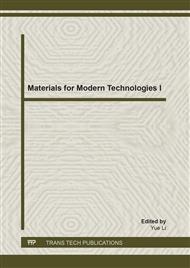[1]
J.A. Ribeiro, A.S. Reis, P.S. Avendaño, C.H. Ataíde, Marcos A.S. Barrozo, Experimental and CFD simulation of a bubble column, Mater. Sci. Forum 727-728 (2012) 1824-1829.
DOI: 10.4028/www.scientific.net/msf.727-728.1824
Google Scholar
[2]
Meng Lei Wang, Zhe Tian, Kui Xing Liu, Research on influence factors of cooling tower performance, Adv. Mater. Research 280 (2011) 119-123.
Google Scholar
[3]
Ji You Fei, Qi Chao Guo, Hua Li, Ran Deng, Study on the intervascular two-phase flow characters of horizontal-tube falling film evaporator, Adv. Mater. Research 516-517 (2012) 208-211.
DOI: 10.4028/www.scientific.net/amr.516-517.208
Google Scholar
[4]
Barry J. Azzopardi, Gas-Liquid Flows, Begell House, New York, (2006).
Google Scholar
[5]
Donald A. Drew, Stephen L. Passman, Theory of Multicomponent Fluids, Springer, New York, (1999).
Google Scholar
[6]
Mikko Manninen, Veikko Taivassalo, Sirpa Kallio, On the mixture model for multiphase flow, VTT Publications, Espoo, Finland, 1996, pp.1-67.
Google Scholar
[7]
Luiz E.M. Lima, Analysis of mixture model applied in gas-liquid isothermals flows, Ph.D. thesis, Mechanical Engineering Faculty, State University of Campinas, Campinas, São Paulo, Brazil, (2011).
Google Scholar
[8]
N. Zuber, J.A. Findlay, Average volumetric concentration in two-phase flow systems, J. Heat Transf. 87 (1965) 453-468.
DOI: 10.1115/1.3689137
Google Scholar
[9]
C. Pauchon, H. Dhulesia, D. Lopez, J. Fabre, TACITE: A comprehensive mechanistic model for two-phase flow, in: A. Wilson (Ed. ), 6th International Conference on Multi Phase Production, BHR Group Limited, Mechanical Engineering Publications Ltd, Cannes, France, 1993, pp.29-50.
Google Scholar
[10]
Y. Taitel, D. Barnea, Two-phase slug flow, in: Advances in Heat Transfer, v. 20, Elsevier, San Diego, California, USA, 1990, pp.83-132.
DOI: 10.1016/s0065-2717(08)70026-1
Google Scholar
[11]
G.A. Gregory, M.K. Nicholson, K. Aziz, Correlation of the liquid volume fraction in the slug for horizontal gas-liquid slug flow, Int. J. of Multiphase Flow 4 (1978) 33-39.
DOI: 10.1016/0301-9322(78)90023-x
Google Scholar
[12]
D. Malnes, Slug flow in vertical, horizontal an inclined pipe, Technical Report, Institute for Energy Technology, Kjeller, Norway, 1982, ReportIFE/KR/E-83/002.
Google Scholar
[13]
D. Barnea, N. Brauner, Holdup of the liquid slug in two phase intermittent flow, Int. J. of Multiphase Flow 11 (1985) 43-49.
DOI: 10.1016/0301-9322(85)90004-7
Google Scholar
[14]
R. Marcano, X.T. Chen, C. Sarica, J.P. Brill, A study of slug characteristics for two-phase horizontal flow, in: International Petroleum Conference and Exhibition of Mexico, Mexico, (1998).
DOI: 10.2118/39856-ms
Google Scholar
[15]
L.E. Gomez, O. Shoham, Y. Taitel, Prediction of slug liquid holdup: horizontal to upward vertical flow, Int. J. of Multiphase Flow 26 (2000) 517-521.
DOI: 10.1016/s0301-9322(99)00025-7
Google Scholar
[16]
G.A. Gregory, D.S. Scott, Correlation of liquid slug velocity and frequency in horizontal cocurrent gas-liquid slug flow, AIChE J. 15 (1969) 933-935.
DOI: 10.1002/aic.690150623
Google Scholar
[17]
E.J. Greskovich, A.L. Shrier, Slug frequency in horizontal gas-liquid slug flow, Industrial & Engineering Chemistry Process Design and Development 11 (1972) 317-318.
DOI: 10.1021/i260042a030
Google Scholar
[18]
N.I. Heywood, J.F. Richardson, Slug flow of air-water mixtures in a horizontal pipe: determination of liquid holdup by γ-ray absorption, Chem. Eng. Sci. 34 (1979) 17-30.
DOI: 10.1016/0009-2509(79)85174-x
Google Scholar
[19]
G. Zabaras, Prediction of slug frequency for gas/liquid flows, Society of Petroleum Engineers J. 5 (2000) 252-258, 65093-PA.
DOI: 10.2118/65093-pa
Google Scholar
[20]
T. Sakaguchi, Correlations for large bubble length, liquid slug length, slug unit length and slug period of gas-liquid two-phase slug flow in vertical pipes, in: E.E. Michaelides (Ed. ), Proceedings of 4th International Conference of Multiphase Flow, Tulane University, New Orleans, USA, (2001).
DOI: 10.1016/0301-9322(93)90046-w
Google Scholar


